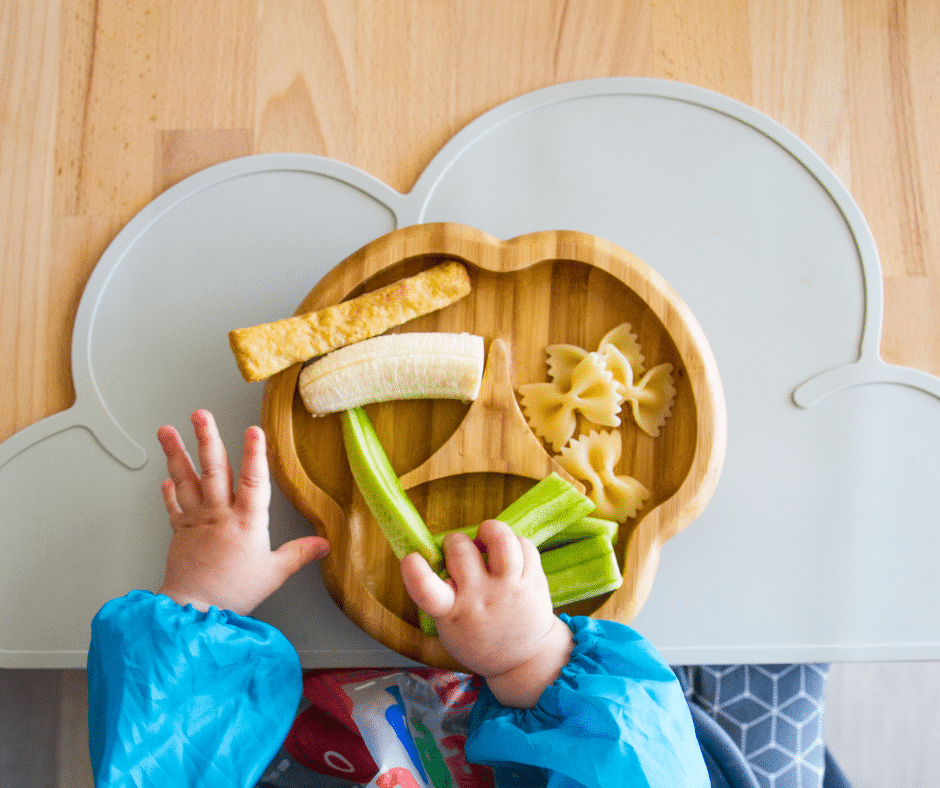Introducing solid foods to your baby can be an exciting and daunting experience for any new parent. “Baby-led weaning” (BLW) is an alternative way of introducing solids to your baby that has become increasingly popular in recent years. Unlike traditional spoon-feeding, BLW encourages babies to feed themselves from the beginning. Here’s everything you need to know about baby-led weaning and starting solids.

What is Baby-Led Weaning?
Baby-led weaning is a method of introducing solid foods to babies that puts the baby in control of what and how much they eat. The idea is that babies are allowed to feed themselves from the beginning, rather than being spoon-fed purees or other mashed-up foods.
With BLW, babies can pick up and explore pieces of food with their hands and put them in their mouths on their own. The aim is to let babies enjoy the experience of tasting and exploring new foods at their own pace and to foster a love of healthy eating habits.
Understanding When to Start Baby-Led Weaning
Before starting BLW, it’s important to know when it’s safe to begin introducing solid foods to your baby. The American Academy of Pediatrics recommends starting around six months of age, when your baby is able to:
- Hold their head up
- Sit up without support
- Show an interest in food by reaching for it or watching you eat
It’s also important to make sure that your baby is ready for solid foods by looking for signs of readiness such as:
- Interest in watching others eat
- Chewing motions, even if they don’t have teeth yet
- Ability to coordinate their tongue and jaw to swallow food
Foods to Offer in Baby-Led Weaning
Offering nutritionally dense foods with variety is key when starting BLW. As a general rule, offer foods that are soft and can be easily grasped by your baby. Some great options include:
- Soft fruits such as avocado, banana, and mango
- Soft-cooked vegetables such as sweet potato, carrot, and zucchini
- Eggs, scrambled or boiled
- Soft meats such as chicken and fish
- Whole-grain toast and crackers
Keep in mind that babies should not be given any honey until they turn one year old, as it may contain spores that could be harmful to infants.
Tips for Getting Started with Baby-Led Weaning
Here are some tips that can help you get started with baby-led weaning:
- Offer a variety of foods in small pieces. Your baby may not take to every food right away, but it’s important to offer a range of foods in small pieces.
- Start off with a small amount of food. To begin with, try offering a small amount of food to your baby. This helps prevent choking and allows your baby to get used to the idea of eating solid foods.
- Let your baby explore the food. Allow your baby to touch, smell, and taste the food on their own. They may make a mess, but that’s part of the learning process.
- Keep a close eye on your baby. Always supervise your baby while they are eating and be aware of the signs of choking.
- Don’t stress over the amount of food your baby eats. Babies will eat what they need, and their appetite may vary from day to day.
Benefits of Baby-Led Weaning
Baby-led weaning has a number of benefits for both babies and parents, including:
- Encourages healthy eating habits from an early age
- Promotes independence and self-regulation
- May reduce picky eating habits later on
- Can foster a positive relationship with food
- Saves time and effort, as there is no need to puree or mash foods

Challenges of Baby-Led Weaning
Like any new way of introducing solids, baby-led weaning can present some challenges, including:
- Messy mealtimes as babies learn how to eat on their own.
- Potential for choking – always be aware of the signs of choking and supervise your baby while they eat.
- Slow start – babies may take a bit longer to start eating with baby-led weaning, as they are learning how to feed themselves.
Baby-led weaning is a great way to introduce solid foods to your baby, giving them the opportunity to eat on their own and explore different foods at their own pace. Be sure to start at the right time, offer a variety of healthy foods, and supervise your baby closely while they eat. With patience and a little bit of mess, you can be sure to give your baby the best possible start to their healthy eating habits.
